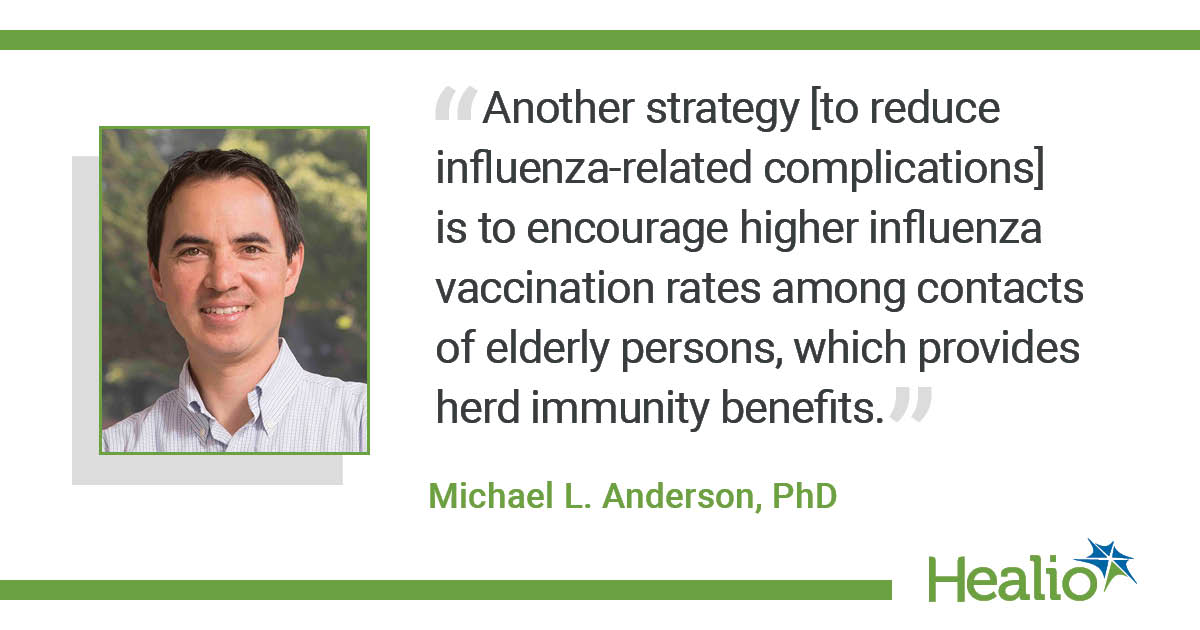Flu vaccination does not reduce hospitalizations, death in older adults
Click Here to Manage Email Alerts
Influenza vaccination strategies targeting older adults may not be as effective as previously thought, according to a study published in the Annals of Internal Medicine that found increased vaccination rates did not reduce hospitalizations or mortalities among adults aged 65 years and older.
“Previous studies, which used research designs that were at greater risk of confounding, found that the standard seasonal influenza vaccine decreased hospitalization and mortality rates for the elderly by double-digit percentages,” Michael L. Anderson, PhD, an associate professor in the department of agricultural and resource economics at the University of California, Berkeley, told Healio Primary Care. “Unfortunately, we found effectiveness against these severe outcomes to be much lower, and not significantly different than zero.”
Influenza vaccination policies in the United Kingdom prioritize adults aged 65 years and older. Anderson and colleagues conducted a regression discontinuity analysis to determine whether an increase in vaccination uptake at 65 years corresponds with a decrease in poor health outcomes. The researchers used observational data from patient survey responses and administrative records to assess vaccination uptake, hospitalizations and mortality among adults aged 55 to 75 years who lived in the United Kingdom from 2000 to 2014.
A total of 170 million care episodes and 7.6 million deaths were evaluated in the study.

Anderson and colleagues found that turning 65 years old was associated with a significant increase in influenza vaccination uptake. The rate increased by 22.8 percentage points (95% CI, 21.7-23.9) among those included in administrative data and by 19.3 percentage points (95% CI, 15.8-22.9) in those included in survey data.
Despite the sharp increase in vaccination uptake after turning 65 years old, the hospitalization rate did not significantly change, according to the researchers. The total hospitalization rate increased by 9.1 (95% CI, –1.4 to 19.6) per 10,000 persons at age 65 years, and the implied effectiveness of increased vaccination was –3.9% (95% CI, –8.5% to 0.6%).
At age 65 years, the number of hospitalizations for influenza and pneumonia increased by 0.6 (95% CI, –1.5 to 2.7) per 10,000 persons, and the estimated effect of increased vaccination uptake on these hospitalizations was –5.8% (95% CI, –25.3% to 12.9%).
The researchers also found mortality rates did not significantly change. The overall mortality rate increased by 1.1 per 10,000 persons (95% CI, –1 to 3.3) at age 65 years. After rescaling to account for the increase in vaccination, researchers estimated the vaccine effectiveness for all-cause mortality was –4.3% (95% CI, –12.6% to 3.8%).
At age 65 years, Anderson and colleagues found influenza and pneumonia-related mortality increased by 0.6 per 10,000 persons (95% CI, –0.2 to 1.4) and rescaling for change in vaccinations showed the effectiveness of vaccination was –17.3% (95% CI, –40.7% to 6%) on these deaths.
To optimize influenza vaccination, Anderson encouraged health care providers to recommend high-dose vaccinations to older adults, as clinical trial results imply “they are more effective at protecting against seasonal influenza for this age group.”
“Another strategy is to encourage higher influenza vaccination rates among contacts of elderly persons, which provides herd immunity benefits,” he added. – by Erin Michael
Disclosures: Anderson reports no relevant financial disclosures. Please see study for all other authors’ relevant financial disclosures.
